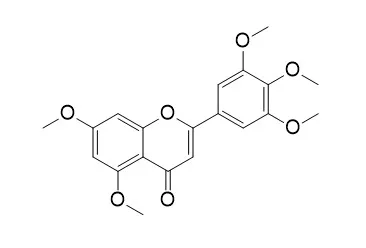| In vitro: |
| Evid Based Complement Alternat Med. 2018 Dec 2;2018:9806160. | | Apoptosis Effects of Dihydrokaempferol Isolated from Bauhinia championii on Synoviocytes.[Pubmed: 30622621 ] | Bauhinia championii (Benth.) Benth. is a traditional medicinal plant used in China to treat rheumatoid arthritis (RA), especially in She ethnic minority group. This study focused on the active constituents from the rattan of B. championii (Benth.) Benth., which possess potential apoptosis effects.
METHODS AND RESULTS:
A conventional phytochemical separation method for the isolation of compounds from the ethyl acetate extract of B. championii was developed. The procedure involved extraction, liquid-liquid partitioning with ethyl acetate, and subsequent compound purification, respectively. Additionally, cell viability of dihydrokaempferol found abundantly in it was evaluated in vitro by MTS, and the antiapoptosis effect was evaluated by annexin V/PI staining (Flow Cytometry Analysis) and western blot. The results showed that nine flavonoids, and five other compounds, were isolated from the ethyl acetate extract of B. championii and were identified as β-sitosterol (1), 5,6,7,3',4',5'-hexamethoxyflavone (2), 3',4',5,7-tetrahydroxyflavone (3), 5,7,3',4',5'-Pentamethoxyflavone (4), 4'-hydroxy-5,7,3',5'-pentamethoxyflavone (5), apigenin (6), liquiritigenin (7), 5, 7-dihydroxylcoumarin (8), 3',4',5,7, -pentamethoxyflavone (9), n-octadecanoate (10), lupine ketone (11), dibutylphthalate (12), dihydrokaempferol (13), and 5,7,3',5'-tetrahydroxy-6-methylflavanone (14). Among these compounds, 5-14 were isolated for the first time from B. championii. In addition, apoptosis effects of abundant dihydrokaempferol were evaluated in vitro. Dihydrokaempferol exhibited inhibitory effects on the proliferation of synoviocytes. Furthermore, dihydrokaempferol promoted Bax and Bad expression, as well as the cleavage of caspase-9, caspase-3, and PARP. Meanwhile, it inhibited Bcl-2 and Bcl-xL expression.
CONCLUSIONS:
These findings indicate that dihydrokaempferol isolated from the ethyl acetate extract of B. championii effectively promotes apoptosis, which is an important process through suppression of apoptotic activity. The results are encouraging for further studies on the use of B. championii in the treatment of RA. | | Cancer Prev Res (Phila). 2009 Aug;2(8):743-50. | | Flavones as colorectal cancer chemopreventive agents--phenol-o-methylation enhances efficacy.[Pubmed: 19638489 ] | Flavonoids occur ubiquitously in plants, and some possess preclinical cancer chemopreventive activity. Little is known about molecular features that mediate chemopreventive efficacy of flavonoids.
METHODS AND RESULTS:
Here, three related flavones, apigenin (4',5,7-trihydroxyflavone), tricin (4',5,7-trihydroxy-3',5'-dimethoxyflavone), and 3',4',5',5,7-pentamethoxyflavone (5,7,3',4',5'-Pentamethoxyflavone,PMF), were compared in terms of their effects on (a) adenoma development in Apc(Min) mice, a model of human gastrointestinal malignancies; (b) growth of APC10.1 mouse adenoma cells in vitro; and (c) prostaglandin E-2 generation in HCA-7 human-derived colorectal cancer cells in vitro. Life-long consumption of PMF with the diet at 0.2% reduced Apc(Min) mouse adenoma number and burden by 43% and 61%, respectively, whereas apigenin was inactive. Tricin has previously shown activity in this model. IC50 values for murine adenoma cell growth inhibition by PMF, tricin, and apigenin were 6, 13, and 18 micromol/L, respectively. In Apc(Min) mice that received flavones (0.2%) for 4 weeks, adenoma cell proliferation as reflected by Ki-67 staining was reduced by PMF and tricin, but not by apigenin. On incubation with HCA-7 cells for 6 hours, PMF reduced prostaglandin E-2 generation with an IC50 of 0.8 micromol/L, a fraction of the respective values reported for tricin or apigenin. In silico PMF docked into the cyclooxygenase active site with greater affinity than tricin or apigenin.
CONCLUSIONS:
The results suggest that the rank order of cancer chemopreventive efficacy in Apc(Min) mice is PMF > tricin > apigenin, supporting the notion that the presence of O-methyl in the flavone molecular scaffold promotes gastrointestinal cancer chemopreventive efficacy. |
|






 Cell. 2018 Jan 11;172(1-2):249-261.e12. doi: 10.1016/j.cell.2017.12.019.IF=36.216(2019)
Cell. 2018 Jan 11;172(1-2):249-261.e12. doi: 10.1016/j.cell.2017.12.019.IF=36.216(2019) Cell Metab. 2020 Mar 3;31(3):534-548.e5. doi: 10.1016/j.cmet.2020.01.002.IF=22.415(2019)
Cell Metab. 2020 Mar 3;31(3):534-548.e5. doi: 10.1016/j.cmet.2020.01.002.IF=22.415(2019) Mol Cell. 2017 Nov 16;68(4):673-685.e6. doi: 10.1016/j.molcel.2017.10.022.IF=14.548(2019)
Mol Cell. 2017 Nov 16;68(4):673-685.e6. doi: 10.1016/j.molcel.2017.10.022.IF=14.548(2019)